Martial Arts: Article about Fightingarts.com Founder and Editor
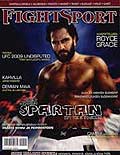 |
The cover of the September 2009 issue of FightSport, a Finnish mixed martial arts magazine in which the following article appeared. |
Christopher Caile:
The Man Who Brought Karate to Finland
By Jarmo Osterman
Translated into English by Kristiina St.Croix
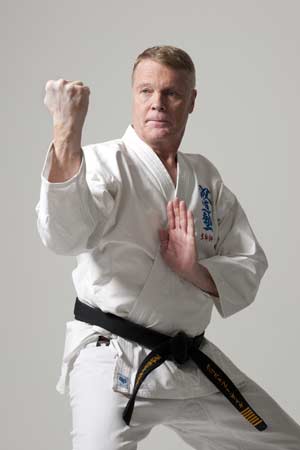 |
Christopher Caile (Shuseki Shihan, 7th dan) performing a move from the karate kata Seienchin. |
Christopher Caile has a master's degree in International Politics. He could also be granted a Master's Degree in martial Arts. Caile, celebrating his 50th year in Martial arts, has practiced many different styles of Martial Arts.
Sometimes the interviewer gets the feeling of being really small. Like during the interview with Shihan Caile. Although, we do have something in common: we both let out our first ‘Kiai- shouts’ in 1959. The only difference is that mine was in the labor-ward of Heideken Hospital and Christopher Caile´s one was in a class of Karate for beginners in Peoria, Illinois, about 7000kms from me.
Christopher Caile was the first person to introduce Karate in Finland. Caile, who lives in New York, still practices Martial arts. In addition to Karate, he also practices aikido and aikijutsu. Caile has also practiced several different styles of Kung Fu.
KIBA-DACHI
Christopher Caile got interested in the Martial arts in 1959 during his studies at Bradley University in Peoria, Illinois. He was introduced to judo and wrestling in a college physical education class, but soon sought more concentrated studies in a judo school run by Douglas Grose. There Caile met Phillip Koeppel who had been practicing Wado-ryu Karate during his Army years in Japan and Shorin-ryu Karate taught by Richard Kim. In Hawaii Koeppel had learnt Kajukembo (a mixture of karate, tang soo do, judo, jujitsu, kenpo and kung fu) which he called kempo.
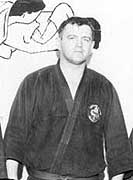 |
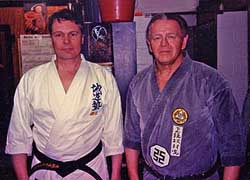 |
Left: A 1963 photo of Phillip Koeppel Sensei, Christopher Caile's first karate teacher, who would become Regional Director for Robert Trias's US Shorin-ryu organization (Trias is often called the father of US karate due to his pioneering efforts), later founding his own international organization, The United States Karate Do Kai, based on his studies of Hohan Soken's karate.
Right: A photo of Christopher Caile with Phillip Koeppel in 1994 during a visit to Koeppel's headquarters dojo in Peoria, Illinois. The two remain friends to this day. |
Because Koeppel had to pay his share of the rent in the dojo, he decided to take on a few students. Ten prospective students turned up for the occasion. Koeppel decided to put the students to the test of endurance. He told them to take a kiba-dachi (horse) stance and left for lunch. Returning an hour and one half later with a toothpick in his mouth, there were only two very determined students left still standing in the position. One of them was Christopher Caile. After his studies with Koeppel during the school year, the next summer Caile practiced at a Shotokan dojo (and started teaching beginning students) and was granted a brown belt. By the time Caile came to Finland, his Karate was a combination of many different styles.
THE OLYMPICS
Phillip Koeppel had advised Caile that if he was really interested in karate he should go to Japan. Caile, however was just thinking about going to the summer Olympics in Rome in 1960 and see a little of Europe. In high school he had been at a national level in shot put and discus (second in New York State in shot put and fifth in the eastern US).
Once in Rome Caile was introduced to members of the Finnish Olympic Team. The team members became friendly with Caile and several loaned him one of the Finnish Olympic outfits (and around the neck ID credentials) which allowed him to move freely in the Olympic stadium (he did a lot of stretching so not to seem conspicuous). They also invited him to visit Finland after the games. He decided to accept their invitation.
Caile, however, had run out of money. So some friends emptied their pockets and gave Caile some local currency and a handful of coins (which amounted to about $30). Caile then hitchhiked northward. He arrived in Helsinki by boat from Germany and stayed with two visiting member of the US Olympic team (one a marathoner, Buddy Edlen). With them Caile took part in a number of track and field competitions in Finland and Sweden for which he was given small cash competition payments. He also started to teach English in the Berlitz Language School in Helsinki.
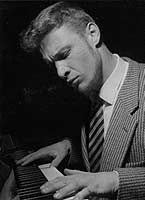 |
Christopher Caile's roommate in Helsinki, Jussi Ikonen, practicing on the piano. Ikonen was a pioneer of Finnish Judo and Caile's judo teacher while in Finland. |
Soon Caile started looking for a karate dojo. Finding none, he got in touch with the Finnish Judo Association and he started practicing judo at their headquarters in Helsinki. He participated the Associations 1960 open national judo tournaments, placing fourth.
At the dojo Caile met Jussi Ikonen (the head judo instructor who was also in medical school at that time) and was invited to live with him in his small one bedroom flat. Caile also attended lectures at the University of Helsinki in Russian architecture (taught by a visiting professor from the University of Indiana, Dr. Ginsburg, who had fought in the 1917 Russian Revolution on the losing side). With his professor Caile traveled to the Soviet Union visiting Moscow, Leningrad and several other locations. Caile brought back a bag full of caviar which he hoped to sell to restaurants to pay for his trip and make a little extra money too. Restaurants, however, were not interested in the idea, so he was left with it.
"When he had no money for dinner," Caile recounts, "we often had to resort to our old stand-by, caviar on toast" Jussi used to proclaim, "no, not that again."
At this time there was a lot of interest in karate in Finland, but there were no teachers. This led to the Judo Association organizing facilities for Caile to teach karate for beginners. Most of the students were already practicing judo. A few best known ones in addition to Jussi Ikonen were Kyösti and Simo Korpiola.
Christopher Caile spent six months in Finland. Ikonen mentioned in his memoirs that when Caile left, the only thing left behind was his glass eye. "Well, it was not quite like that," says Caile. He had lost his eye in an accident at the age of seven and wore a plastic artificial-eye (similar to a large, thick removable contact lens). As he occasionally did, one night he removed it to rest his eye socket and then washing and wrapping it in a paper Kleenex he placed it on a bedside table. The next morning without thinking he picked up the Kleenex and threw in the toilet, flushing it down. When he realized his mistake, Caile became desperate to find a quick replacement since he had been invited to have Christmas dinner a few days later with the family of his girlfriend.
Caile saw Jussi Ikonen (1934-2006) for the last time several years later. Ikonen and his girlfriend were returning from Japan (having crossed the US in an old junk car they had purchased) and came to visit. They stayed several weeks with Caile in his home in Armonk, outside New York City.
VISIT TO JAPAN
Caile had thought of going to Japan, but when Ikonen suggested that he would meet him there, Caile became convinced of the idea. But for Caile, money was a problem. He had had managed to save up only a few hundred dollars in Finland. Therefore, he decided to hitchhike most of the journey. "I hitchhiked anything that moved," says Caile, "cars, trucks, buses, trains (even on the top of them) and boats. There were many adventures, says Caile. "For example, I traveled across India and up into the Himalayas (in Nepal) in an old WW II junk Jeep with no top, no lights, no front windows and floor boards with huge holes. I had been picked up by a young man on his way across India and at night when driving along remote dirt roads I would lay out over the hood with a flashlight in my hand so I could see to direct him."
Caile recounts that during his travels he was limited in his daily allowance for food and accommodation to mere a dollar a day in Europe and twenty five cents a day for the rest of the trip. Because of this he was constantly hungry and often slept outside. The lack of money, however, did not stop him. Starting off northward from Helsinki he first visited a small remote Lapp village in the artic north of Finnish Lapland (Lapps are known for their colorful clothes and reindeer herding). He must have been quite a sight wading through several miles of deep snow in his street clothes with a suitcase strapped to his back.
On the way to Japan Caile traveled through 43 counties in Scandinavia, Europe, North Africa, the Middle East, Asia and the South-East Asia. His journey from Helsinki to Nippon took him well over a year. Ikonen remembered a chance meeting with Caile in Holland not long after Caile had started out from Finland. This time, of course, at a dojo.
DONN DRAEGER
On his arrival in Japan, Caile wasn't sure what to do next, but he remembered a contact name and number he had been given by a photographer in Germany, "Just in case you need it," he had been told. After much searching he found a small crunched-up piece of paper wedged in a corner of his backpack, which he evened out. On it in blurred letters was the name of the budo-icon Donn Draeger (well known for his practice of many traditional Japanese martial arts and his expertise in judo) along with his address and telephone number. Later Draeger became famous in the west for his research and his series of texts on classical Japanese martial arts. He gave Caile a place to live in his home in Ichigaya, a suburb of Tokyo where other martial artists were also staying, several who would be members of the 1964 USA Olympic Judo team. Over the years many Finnish budo enthusiasts have also lived in Draeger´s house. Christopher Caile remembers Donn Draeger for his hospitality, his gentlemanly demeanor and his serious attitude and practice of budo.
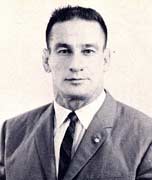 |
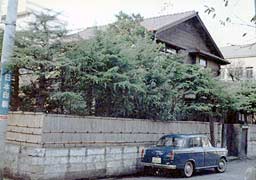 |
Left: Donn Draeger
Right: Donn Draeger's famed Meiji era home in Tokyo where Caile stayed while in Japan. The Meiji house (unique since very few wooden structures from that time survived the fire bombing of WW II) was a Mecca for generations of visiting martial artists including many from Finland. The place has been given notoriety amongst martial artists due to stories about Draeger and his rented house in the well known budo book "Moving Zen." |
Draeger introduced Caile to many different karate dojos as well as to Mas Oyama (Kyokushinkai) at whose dojo Caile decided to start practicing karate. "Practice was really intense and really tough," says Caile (the Oyama dojo was known for its hard, knock down fighting). He remembers his feelings of fear that would whelm up each night before sleep in anticipation for the following day's practice, especially kumite (practice fighting). One night Draeger gave Caile some practical Zen advice.
"If you fear the sword, you will get cut by it," Draeger said. "Forget thinking, forget anticipating. Just concentrate on your opponent." Draeger then went over to a little alcove in his room and came back with a short sword. Telling Caile not to move, Draeger then withdrew the razor sharp sword from the scabbard and whipped it just over Caile´s head making his hair move. Blood ran cold in Caile´s veins. Every single hair on his body stood on end and he felt cold drops of sweat trickle down his face.
"Now, that's fear," said Draeger. "I could have easily killed you, but punches and kicks don't really hurt you. They don't threaten your life. That's why you should not fear them."
"That advice really helped," says Caile. "The next day even Oyama noticed the difference in my attitude and fighting." Caile also noticed that the numerous injuries caused by practicing lessened.
With Draeger, Caile also practiced some Judo (Caile freely noted here he was just a relative beginner compared to Dragger and others who he practiced judo with), weight lifting and jojutsu (Shinto Muso Ryu Jojutsu, the art of the short pole) in the morning and early afternoon. After a little rest Caile would leave to practice karate. "Putting it all together," says Caile, "I guess I was training over 12 hours a day." Then in the evenings, Caile remembers (when not occupied elsewhere) Draeger would often engage him in conversations about budo, its history and philosophy.
SOSAI MASUTATSU OYAMA
Training at Oyama dojo was very hard and there were only about thirty students at any one practice. "I was the only Western student at that time. Oyama constantly encouraged me to carry on." The extremely tough Practice and free fighting at the dojo had driven away many Westerners who had tried to practiced there, Caile notes. Oyama usually recommended that foreign visitors practice at Kenji Kurosaki's Kyokushinkai dojo where free fighting was less severe.
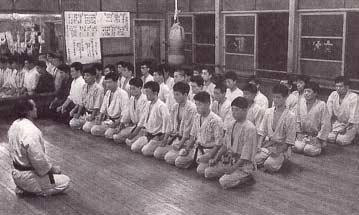 |
A rare photo of Mas Oyama's first Tokyo dojo (located in Ikebukuro) and organization headquarters taken around 1960. It was located in a old wooded two-story building in which Oyama leased the space from a dance studio. At that time the roadway leading to the dojo was still unpaved. |
One session took from three to four hours. It started with the class reciting "dojo kun" (a ritual recital of proper behavior and purpose). Then there was standing and moving basic techniques and kata. Then for the second half of the class there was free fighting. Four or five of the best fighters would line up across the dojo (other students seated along the edges) inviting students to get up and fight them. Even beginners were expected to fight from the beginning. Class would often end with Oyama giving a lecture on karate to students sitting in seiza (a kneeling position), Caile remembers.
 |
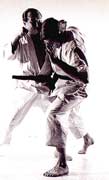 |
Left:Mas Oyama blocking a punch from Christopher Caile, a photo which appeared in Mas Oyama's book, "This Is karate."
Right:Mas Oyama fighting Christopher Caile. This photo is one of many taken in 1961 for Oyama's master work, "This Is Karate," showing Caile and Oyama in various fighting situations. They have appeared in countless magazines and books documenting Kyokushinkai karate history. An illustration of this photo was used for a cover of a 1994 Kyokushinkai Karate magazine. |
Caile remembers his first day in class when he got up to free fight. When he assumed a small horse stance, Oyama immediately called out to stop, warning him about this position. But the young man assured Oyama that he was used to this position. Caile quickly changed his opinion. The first three techniques thrown at him were sharp kicks in his groin (no groin cups were allowed) which floored him. Caile rolled around in agony. "I learned in five minutes something I had missed before in my training," says Caile.
“Never tell your
weaknesses to
your opponent” |
|
During the first several months of practice Caile was taken to one of the hospitals in Tokyo frequently with injuries from practicing at the dojo. But Caile always returned to practice the following day.
One of his worst injuries was when Kenji Kurosaki Sensei (Caile practiced in his dojo twice a week when Oyama wasn't giving classes) kicked Caile on the chin knocking him out, along with two teeth. Two others were broken off at the gum line. That evening two teeth were wired back in place by a local dentist.
On the following day (back at Oyama's dojo), Caile mumbled about his injury to his first sparring opponent, hoping to avoid any further injury. The opponent, however, quickly hit Caile in the same spot, loosening his teeth again (requiring that they be rewired back into place). After the training Caile asked this opponent why had he done so. The opponent replied, “Never tell your weaknesses to your opponent.”
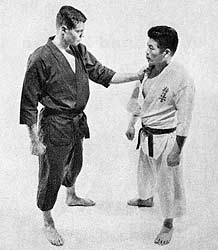
|
Christopher Caile and Kenji Kurosaki at the start of a self-defense technique shot for inclusion in Mas Oyama's book, "This Is Karate." Kurosaki, originally a Goju-ryu practitioner under Gogen Yamaguchi whereMas Oyama was practicing, left with Oyama when he decided to form his own organization. Later he broke away starting his own Dojo, the Mejiro Gym, (later called the Kurosaki Dojo) which quickly became one of the leading Japanese Kick Boxing Dojos in Japan. He is also the Honorary President of Jon Bluming's International Budo Federation (Bluming is a former 6th dan karate-ka under Mas Oyama's Kyokushinkai and an internationally famed judo champion), a mixed martial arts organization. |
It took Christopher Caile a few months to get used to the hard training, but little by little he learned to protect himself. And finally one day Oyama signaled him to join that small group of fighters that lined up across the dojo with whom others could chose to fight. "That's when my offensive techniques really began to develop," says Caile.
On weekends and on many evenings Oyama took the young man (Caile) to Sensei Kurosaki´s dojo where they were taking photos for Oyama´s forthcoming master work, "This Is Karate." Caile had the honor of posing as Oyama's partner in many of the techniques and fighting shots. Caile is annoyed because some critics have suggested that some of the breaking photos were staged (false). "They were real," Caile says. "I was there and helped set up many of those breaking materials."
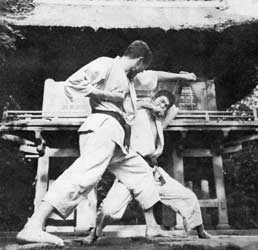 |
Summer training in Japan on the grounds of a temple outside Tokyo in 1961. Christopher Caile (left) strikes and another kyokushinkai student blocks the blow with an elbow-strike. This photo is one of Caile´s favorites. |
In addition to training with Oyama three times weekly, on alternate days he practiced at Sensei Kurosaki´s dojo (also located in Tokyo and the only other Kyokushinkai dojo in Japan at that time).
Caile remembers Sensei Kurosaki (5th dan, Oyama's highest ranking student at that time) as being very strong and flexible. "He could side-kick to Caile's chest without moving (leaning) his body. His wrists were thick and his arms were very muscular. Kurosaki often practiced sword cuts using a weight lifting bar.
On Sundays Caile accompanied Sensei Oyama (along with Tadashi Nakamura) to visit a US military base north of Tokyo, Camp Zama, to teach karate to American soldiers. His small Japanese-English pocket dictionary was in vigorous use during these trips.
TADASHI NAKAMURA
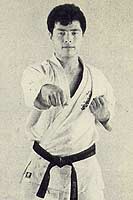 |
Tadashi Nakamura in 1961 |
On the first day at the Oyama dojo, Mas Oyama introduced Caile to his star-pupil, Tadashi Nakamura, and asked him to teach Nakamura some English. Caile and Nakamura often had lunch together and practiced English. Eventually these two men became good friends and often sparred together at the dojo. Caile remembers how Nakamura would kick and punch him really hard. He especially remembers how Nakamura's round house kick seemed to always end up hitting him in the same spot on his chest (solar plexus). Caile says, "It was as if his roundhouse kick was surgically implanted in my chest." Despite this Caile noticed how controlled the kicks and punches were (not designed to injure him). One day he asked Nakamura why he hit him so hard? Nakamura answered, "Because I am your friend." Caile says he had to think about this for a while before he understood.
To underscore the level of fighting in those days, Caile notes that several years after his departure from Japan, Nakamura and Kurosaki were part of a three man Kyokushinkai team that represented Japanese karate in Bangkok in a challenge match against Thailand's Muay Thai kick boxing champions. The Kyokushinkai team won, two matches to one.
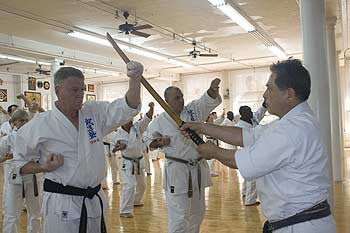 |
Kaicho Tadashi Nakamura founder ofWorld Seido karate tests Christopher Caile's upper block during a training session for senior black belts at the organizations headquarters in New York City in 2009. |
|